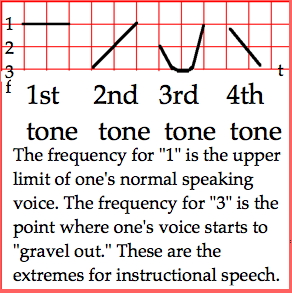Stroke order principles for learning how to write Chinese characters correctly are available here.
Readings in traditional Chinese characters are available here.
Flashcards to accompany the above stories are available here.
K-12 Chinese here.
Learn Chinese -- with no English to interfere. "Wok" just means "wok," not
"concave frying pan." Directly understand Chinese words! Chinese
Direct Ⓒ 2011 Patrick Edwin Moran
Chinese is a tonal language, and Mandarin (standard instructional) Chinese
has four tones plus an unaccented version of syllables that is called
"neutral tone" or "light tone."

One way to introduce these tones is to explain the meaning of the sound
spelled out as "ma" when it has each of the four tones, and when it is in
neutral tone.
first tone: mā "mother." (māma is
the ordinary Chinese way to say "mama.")
second tone: má hemp.
third tone: mǎ horse
fourth tone: mà to revile, to
scold.
neutral tone: ma (this sound at the end of a sentence
makes that sentence a questsion.)
Note that the little superscripts over each of the first four words listed
above are simplified versions of the frequency vs. time graphs in the big
chart.
Do not be too concerned about how to use tones. In the beginning, reading
syllable by syllable, they may feel a bit awkward. However, if you always do
your best to reproduce the sound that is presented in the vocabulary
pronunciation file, you will form good habits for their production. When you
learn to speak more quickly you will naturally begin to glide them together.
Do not imagine, however, that you can just ignore them. Sometimes when you
get them wrong you can unintentionally say something that has an unintended
meaning that you would not want to convey.
Lesson 01. A dozen vocabulary items, and the
idea that (as in English) single-syllable modifiers come directly before the
noun. The speech sounds not found in English, xi, sh, ri, and yü, are used
for the first time.
Lesson 02. Lesson two introduces some common
kinship terms used within the family, for instance, "mom," "dad," and terms
for elder and younger siblings. It also introduces two different kinds of
sentences, (1) Subject + attribute (and no copula), and (2) Subject + set
inclusion operator + name of set (Rover belongs-in-the-set-of dogs).
Web
Version. (In progress.)
When two syllables are closely connected in speech, the first syllable takes
precedence and the second syllable may not have an easily distinguishable
tone. When two or more third tones, e.g. as in "mǎ," the first one of
them becomes a second (rising) tone, e.g., "mámǎ." A similar thing
happens with "bù" (meaning no) when it comes before another fourth tone. The
word "bù" is then pronounced as "bú," so that "bù shì" has to be read as "bú
shì." Furthermore, commonly used expressions such as "bú shì" usually lose
the tone of the second syllable except when being very carefully pronounced
under special circumstances. So "bú shì" usually appears
as "búshi." (There is no pause between the two syllables.)
Lesson 03.
guests
